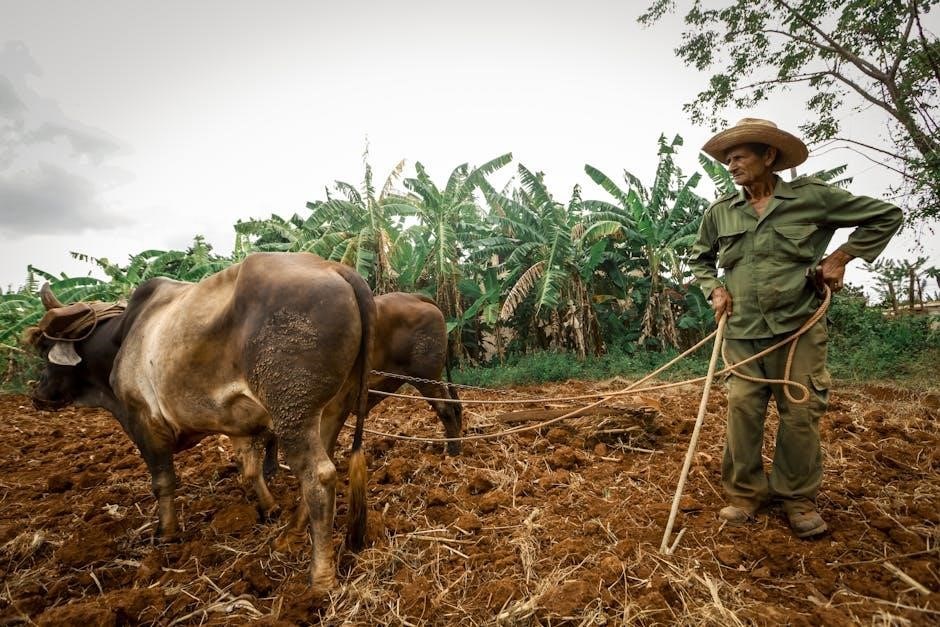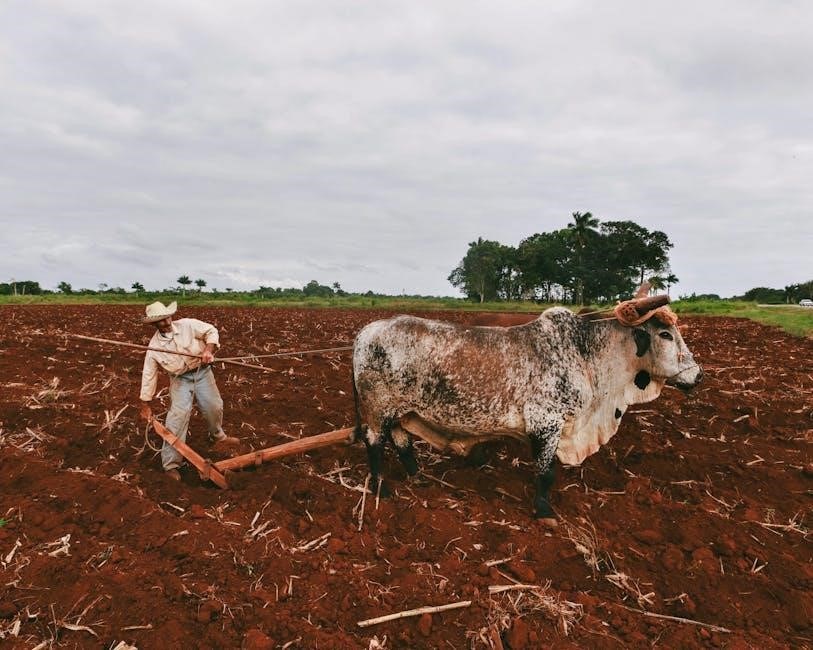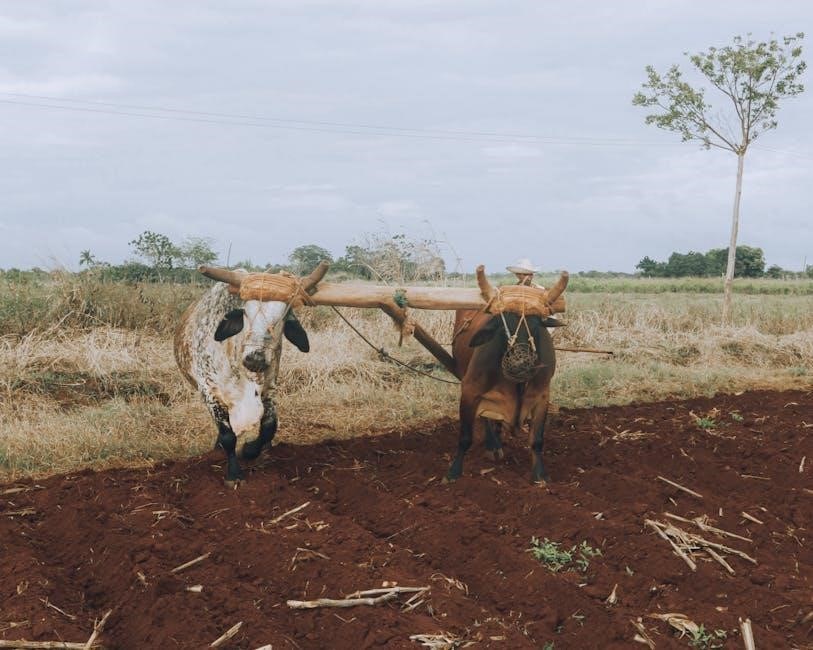
Manual plows are agricultural tools used for soil preparation, featuring various designs, with a long history, and are still used today, with wooden handles and metal blades, for farming and gardening purposes effectively always.
Definition and Purpose
A manual plow is defined as a simple agricultural tool used to loosen and turn soil, typically featuring a wooden handle and a metal blade. The primary purpose of a manual plow is to prepare the soil for planting seeds, removing weeds, and cultivating the ground. This tool has been used for centuries, with its design evolving over time to become more efficient and effective. The manual plow is an essential instrument for farmers and gardeners, allowing them to work the soil without relying on machinery. Its simplicity and versatility make it an ideal choice for small-scale farming and gardening operations. The manual plow is also used to aerate the soil, helping to improve its structure and fertility. By using a manual plow, individuals can cultivate their land with ease, promoting healthy plant growth and sustainable agricultural practices. Overall, the manual plow is a valuable tool that serves a crucial purpose in agricultural activities.

History and Development
Manual plows originated from prehistoric digging sticks, evolving over time with new materials and designs, shaping agriculture and farming practices effectively always with significant impact.
Evolution of Plows
The evolution of plows has been a gradual process, with early plows being made from wood and stone, and later from iron and steel, allowing for more efficient farming practices.
The introduction of the wheel has also played a significant role in the development of plows, enabling farmers to cultivate larger areas of land with less effort.
Over time, plows have become more sophisticated, with the addition of features such as moldboards and shares, which have improved their ability to turn and break up soil.
The evolution of plows has also been influenced by advances in technology, such as the development of new materials and manufacturing techniques, which have enabled the production of more durable and efficient plows.
As a result, modern plows are capable of performing a wide range of tasks, from preparing soil for planting to controlling weeds and managing crop residues, making them an essential tool for farmers around the world, with various designs and applications.

Types of Manual Plows
Manual plows include walking plows, horse-drawn plows, and ox-drawn plows, each with unique features and uses, for farming and gardening purposes, with various designs always effectively.
Walking Plows
Walking plows are a type of manual plow that is designed to be used by a person walking behind it, typically used for small-scale farming and gardening.
These plows are usually made of iron and wood, and have been used throughout history, with examples such as the Gloucestershire Long Plough.
The walking plow is a simple and effective tool for cultivating the soil, and is often used for shallow to shallow plowing.
It is typically characterized by its small size and lightweight design, making it easy to maneuver and use.
The walking plow is also often used for seedbed creation and soil preparation, and is a popular choice for small-scale farmers and gardeners.
The use of walking plows has been documented throughout history, and they remain a popular choice for many farmers and gardeners today, due to their simplicity and effectiveness.
Overall, walking plows are an important part of agricultural history and continue to be used today, with their unique design and functionality making them a valuable tool for many farmers and gardeners.

Components of a Manual Plow
Manual plows consist of frames, handles, and metal blades, working together effectively always.
Handle and Frame
The handle and frame of a manual plow are crucial components, providing the necessary support and leverage for the user to effectively cultivate the soil. The handle is typically made of wood or other durable materials, shaped to fit comfortably in the user’s hands. The frame, on the other hand, is usually constructed from iron or steel, providing the structural integrity needed to withstand the rigors of plowing. The design of the handle and frame can vary depending on the type of plow and the intended use, with some plows featuring adjustable handles or collapsible frames for easier storage and transport. Overall, the handle and frame work together to enable the user to control the plow and achieve the desired results, making them essential components of a manual plow. The materials used and the design of these components can affect the overall performance of the plow.
Metal Blade
The metal blade of a manual plow is a critical component, responsible for cutting through the soil and creating furrows for planting seeds or removing weeds. The blade is typically made of a durable metal, such as iron or steel, and is designed to be sharp and effective at cutting through various types of soil. The shape and size of the blade can vary depending on the type of plow and the intended use, with some plows featuring curved or angled blades for specific tasks. The metal blade is usually attached to the frame of the plow, and is designed to be replaceable if it becomes worn or damaged. Proper maintenance of the metal blade is essential to ensure effective performance and to extend the life of the plow. Regular sharpening and cleaning of the blade can help to maintain its effectiveness and prevent damage to the plow.

Uses of Manual Plows
Manual plows are used for farming and gardening purposes, including soil preparation and crop management, effectively always with ease and efficiency in various environments and conditions always.
Soil Preparation
Manual plows play a crucial role in soil preparation, which is essential for farming and gardening. The process involves loosening and turning the soil to create a favorable environment for plant growth. This can be achieved by using a manual plow to break up clods and aerate the soil, allowing for better water penetration and root development. Effective soil preparation using a manual plow can help to improve soil structure, increase crop yields, and reduce the need for fertilizers and pesticides. Additionally, manual plows can be used to incorporate organic matter into the soil, such as compost or manure, which can help to improve soil fertility and overall health. By using a manual plow for soil preparation, farmers and gardeners can create a healthy and productive soil environment that supports plant growth and development. This is a time-consuming process but it is very effective and efficient.
Seedbed Creation
Manual plows are used to create a seedbed, which is a well-prepared soil surface that is suitable for sowing seeds. The process of seedbed creation involves using a manual plow to break up and loosen the soil, creating a smooth and even surface. This helps to ensure that seeds are sown at the correct depth and are in contact with the soil, which is essential for germination and seedling growth. A well-created seedbed can help to improve crop establishment and reduce the risk of seedling mortality. Manual plows can be used to create a seedbed in a variety of shapes and sizes, depending on the specific needs of the crop being grown. The use of a manual plow for seedbed creation can be a time-consuming process, but it is an effective way to prepare the soil for planting. This process is essential for achieving good crop yields and healthy plant growth always.